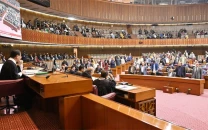It’s the economy, stupid!
With Pakistan in Afghanistan, Pakistan can become the hub of trade routes extend to all four corners of the world

The writer served as Executive Editor of The Express Tribune from 2009 to 2014
The Kashmir-Kashmir trade has the potential of eventually becoming more active via Sialkot, the original trade route of the Valley, which is relatively shorter compared to the existing one that goes all the way through New Delhi. Once this route is activated for the Valley’s export and import, the physical distance between the Valley and Pakistan would shorten considerably. And with China very much involved in the overland routes in Pakistan and fully trained Pakistani and Chinese troops safeguarding them, only a mad adventurer would even think of casting an evil eye on these trading activities.
With there being vested economic interest in keeping the overland trade route to Afghanistan and Central Asia secure for all times to come, India perhaps would itself be keen to help safeguard and protect peace and stability in Pakistan. The hefty amounts that would accrue to Pakistan by way of fees for the use of our roads and overland passage of goods to all four corners of the world would itself be more than enough for us to stop burdening our future generations with costly loans to fund Pakistan’s development needs. This would be in addition to the warehousing and transhipment charges.
At the same time, we’ll also be making economic profits from the Tapi gas pipeline, the CASA-1000 electricity transmission and the Iran-Pakistan gas pipeline, which has the potential to pass through to India once things normalise between Islamabad and New Delhi.
The heightened trading activity throughout the country, as a result, would hopefully facilitate the transfer of various technologies as well as skills that our manpower lacks. Another associated benefit would be the opening up of immense job opportunities for the educated, skilled and semi-skilled manpower of Pakistan.
With so much economic activity going on in the country, international banks, including India-based financial institutions, would like to set up their branches in Pakistan. And Pakistan can set up its banks in India on a reciprocal basis.
Of course, in the limited context of India-Pakistan trading activity — after hopefully the former is granted MFN/NDMA status — the eastern neighbour would certainly have an upper hand in the short run. Still, the fear of cheaper Indian consumer goods flooding our markets is misplaced. In the first place, the supposed subsidy component in the prices of these goods would be more than neutralised by the exchange rate differential between the currencies of India and Pakistan. Secondly, it would not be possible for the cheaper Indian goods of lower quality to capture upscale and even middle-scale markets in Pakistan even in the longer run because of entrenched consumption habits.
The fear that Pakistan’s exports to India would face formidable non-tariff barriers and very high standardisation barricades is real. Also, exports from Bangladesh and Sri Lanka enjoy special concessions in the Indian markets. But this problem can easily be overcome by using the instrument of trade-offs as well as taking advantage of relatively freer movement across the border to invite Indian expertise to help our exporters surmount the non-tariff and standardisation barriers.
Published in The Express Tribune, December 12th, 2015.
Like Opinion & Editorial on Facebook, follow @ETOpEd on Twitter to receive all updates on all our daily pieces.













COMMENTS
Comments are moderated and generally will be posted if they are on-topic and not abusive.
For more information, please see our Comments FAQ